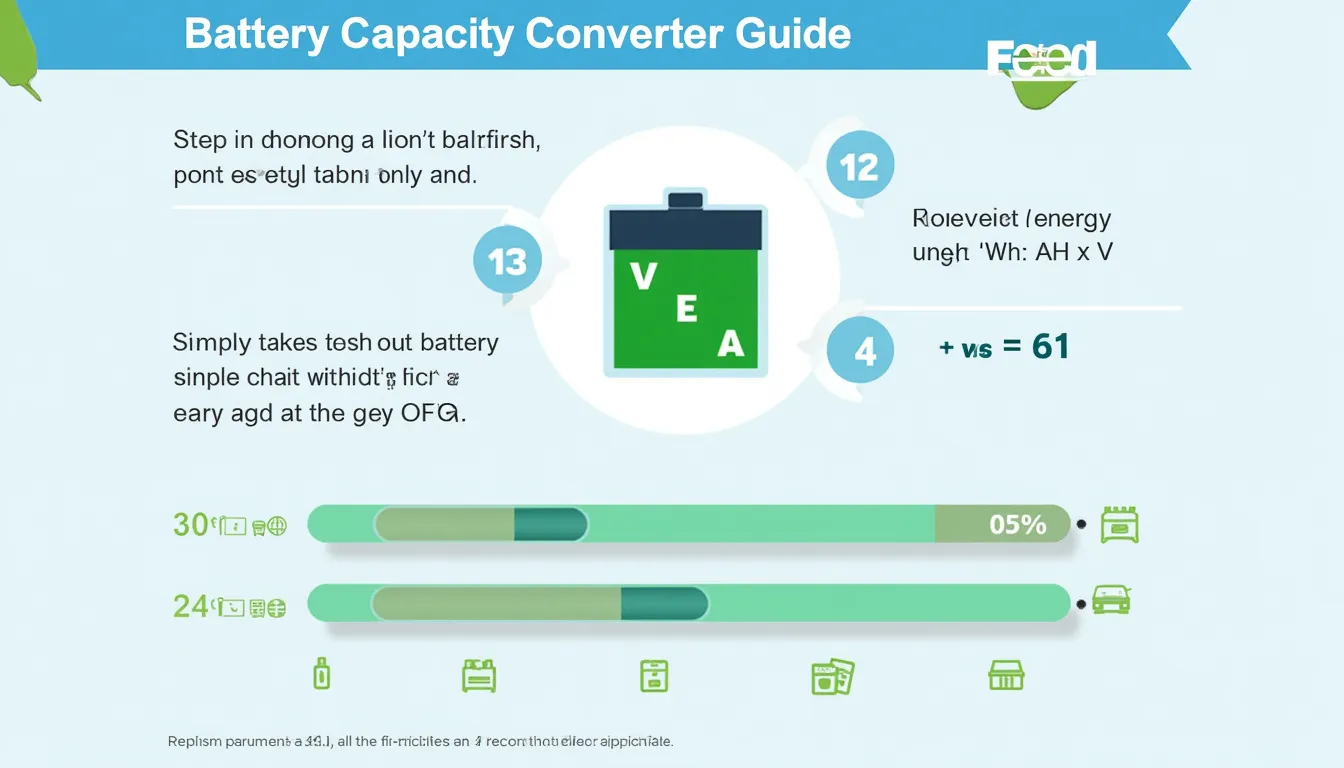Is this tool helpful?
How to use the tool
Use these steps to translate battery capacity across voltage systems:
- 1. Battery Capacity (Ah): Enter 400 or 95 Ah—whatever your datasheet states.
- 2. Initial Voltage (V): Type 48 V or 24 V—the battery’s rated voltage.
- 3. New Voltage (V): Input target voltage such as 120 V or 230 V.
- 4. Conversion Efficiency (%): Add 88 % or 92 % to reflect inverter losses; leave blank for 100 %.
- 5. Convert: The tool returns energy, usable energy, equivalent capacity and current instantly.
Formulas applied
- Energy (Wh) = Ah × V
- Energy (kWh) = Energy (Wh) ⁄ 1000
- Usable Energy (kWh) = Energy (kWh) × rac{Efficiency %}{100}
- New Capacity (Ah) = (Ah × Initial V) ⁄ New V
- Current at New V (A) = Energy (Wh) ⁄ New V (for 1 h discharge)
Example 1
Inputs: 400 Ah, 48 V ➔ 120 V, 88 %.
- Energy = 400 × 48 = 19 200 Wh = 19.2 kWh
- Usable Energy = 19.2 kWh × 0.88 = 16.9 kWh
- New Capacity = (400 × 48)⁄120 = 160 Ah
- Current at 120 V = 19 200 Wh⁄120 V = 160 A
Example 2
Inputs: 100 Ah, 24 V ➔ 230 V, 92 %.
- Energy = 100 × 24 = 2 400 Wh = 2.4 kWh
- Usable Energy = 2.4 kWh × 0.92 = 2.21 kWh
- New Capacity ≈ (100 × 24)⁄230 = 10.43 Ah
- Current at 230 V ≈ 2 400 Wh⁄230 V = 10.43 A
Quick-Facts
- Nominal lithium-ion cell voltage: 3.6 V (Panasonic NCR18650 datasheet, 2020).
- Modern hybrid inverters reach 95 % peak efficiency (NREL PV Field Data, 2022).
- Residential battery systems cost US $600-1 000 per kWh installed (Wood Mackenzie, 2023).
- Limiting depth-of-discharge to 50 % can double cycle life (BatteryUniversity.com, 2023).
FAQ
What is battery capacity?
Battery capacity is the quantity of charge a battery can deliver, expressed in ampere-hours (Ah); one ampere-hour equals supplying 1 A for one hour (IEC 60050, 2018).
How do I convert Ah to kWh?
Multiply capacity (Ah) by voltage (V) to get watt-hours, then divide by 1000 for kilowatt-hours—for example, 150 Ah × 36 V = 5.4 kWh (BatteryUniversity.com, 2023).
Why does changing voltage alter Ah but not energy?
Energy in watt-hours stays constant; lowering voltage raises current or Ah proportionally, preserving the Wh figure (Horowitz & Hill, 2015).
What efficiency should I enter?
Use 90-95 % for quality inverter/charger pairs; older lead-acid systems may see 80-85 % (NREL PV Field Data, 2022).
How do results help size an inverter?
The “Current at New V” value shows peak amperage during a one-hour discharge; choose an inverter that handles that continuous current plus surge margin (Victron Energy manual, 2021).
Which safety standards govern battery packs?
Rechargeable lithium packs must meet IEC 62619 for stationary storage and UL 1973 in North America; both address thermal runaway and cell balancing (“IEC 62619:2017”).
What is today’s typical cost per kWh of storage?
Utility-scale lithium-ion systems averaged US $139 kWh⁻¹ in 2022, an 89 % drop since 2010 (IEA Battery Update, 2023).
Should I correct capacity for temperature?
Yes. Lead-acid batteries lose ≈ 1 % capacity per °C below 25 °C; lithium-ion loses 0.3 % °C⁻¹ (Sandia National Labs, 2022). “Cold cranks kill capacity fast,” notes the Sandia report.
Important Disclaimer
The calculations, results, and content provided by our tools are not guaranteed to be accurate, complete, or reliable. Users are responsible for verifying and interpreting the results. Our content and tools may contain errors, biases, or inconsistencies. Do not enter personal data, sensitive information, or personally identifiable information in our web forms or tools. Such data entry violates our terms of service and may result in unauthorized disclosure to third parties. We reserve the right to save inputs and outputs from our tools for the purposes of error debugging, bias identification, and performance improvement. External companies providing AI models used in our tools may also save and process data in accordance with their own policies. By using our tools, you consent to this data collection and processing. We reserve the right to limit the usage of our tools based on current usability factors.







